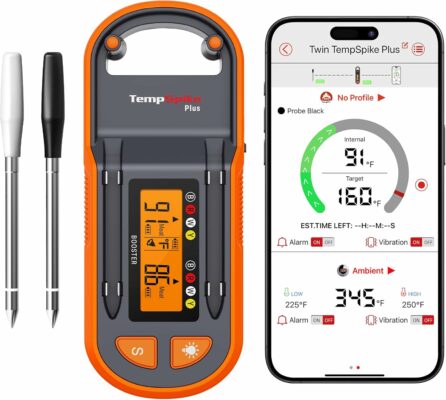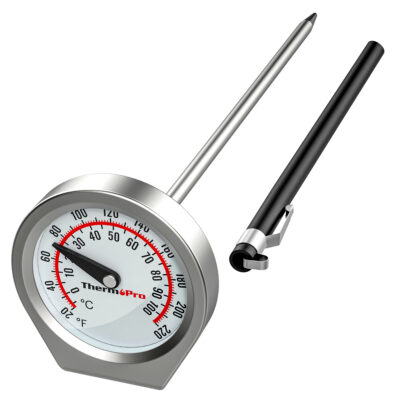The customer service team is always listening, taking notes, and quantifying complaints to ensure our products are continually improved. Due to selling directly to you, the customer, via Amazon, we can use product reviews to help us improve our existing products or help further development of new products.
How to Read a Meat Thermometer
Table of Contents
Using a thermometer to measure the internal temperature of your food is the smart way to determine its level of doneness. Instead of relying on appearance or an unscientific “thumb test”, a cooking thermometer will tell you exactly what you need to know. Unfortunately, these devices can be tricky to use, especially for novices new to this practice. So if you’re wondering how to read a meat thermometer, this short explainer will tell you everything you need to know.
This simple-to-understand guide explains the proper method to read a meat thermometer. As well, you’ll find several tips that simplify the temperature monitoring process. Find the proper results you need to improve your cooking!
Digital vs Analog: Which One is Yours?
As wide and varied as the many available retail products are, cooking thermometers fall into one of two distinct groups: digital, or analog. Digital thermometers use batteries for power and feature a digital display with a numeric readout. On the other hand, analog thermometers do not use batteries and feature a dial. Each has its own advantages and drawbacks, leaving it to you to find the right type to suit your purposes.
With all the many different types of digital thermometers on the market, here’s an explainer on how to read a few of these varieties.
How to Read a Wireless Probe Thermometer
Most digital thermometers feature a screen that displays vital information such as temperature, time, and programmable modes. One such example is the ThermoPro Twin TempSpike Plus Wireless 600-ft Dual Probe Meat Thermometer. This versatile food temperature monitor features two different ways of showing temperatures. These are on your phone using the ThermoPro phone app, or on the display of the Booster Unit. In both cases, the temperature shows up as a numerical value, making it very easy for anyone who wondered, “How do I read a meat thermometer?”
READ: How to Use a Meat Thermometer
The first step to using a wireless probe thermometer is to insert the probe into the ingredient you want to monitor. It is important to perform this step before the cooking process, and not during cooking time.

Built-In Display
By taking a closer look at the screen of the Twin TempSpike Plus Booster Unit (shown above), we can see a wide type of different information. First and foremost, the temperature display is the largest and most prominent. We see this as the “86” display on the right and left sides of the screen (highlighted by the green square).
Even though these both share the same temperature, they are not the same thing. We can tell this due to the sign to the right of both temperatures (highlighted in blue). The left side “Meat” represents the inserted probe sensor that shows the internal temperature of the “meat”. The right side “Amb.” stands for “ambient” and represents the ambient cooking temperature (that is, the temperature of the air outside the ingredient).
Furthermore, because the Twin TempSpike Plus comes equipped with two probes, we see this in the two arrows located at the top of the display. One of the arrows is pointing at “B” and represents the black-colored probe, while the “W” stands for the white-colored probe (highlighted in purple).
Phone Display
And yet, that’s not all. In addition to built-in displays, some models of wireless cooking thermometers are able to display temperatures on your phone via an app. Looking at the Twin TempSpike Plus, we can see that the temperature readout takes up the most prominent area on the screen. This appears at the center of the screen as a digital readout (see highlight in green). As before, there are two temperature readouts to display the readings for the internal temperature of the ingredient. This is seen at center (enclosed within the half-ring) as well as for the ambient temperature of the cooking environment (at bottom center).
In fact, there is a wealth of info located on this screen. As the bottom portion of the screen is used to monitor the ambient temperature of the cooking environment, this is seen in the “Ambient” sign (highlighted in blue). And because there is more than one probe, the app display helps us stay organized. It keeps track of which probe is being displayed. In this case, it is the black-colored probe (as highlighted in purple at top left).
How to Read an Instant-Read Thermometer
Another popular type of digital thermometer is the instant-read thermometer. Unlike the probe thermometer that are inserted into the food during the entire process, the instant-read thermometers are only used at the end. They are used to determine the doneness of the food, and even then are only used for a short period of time.
One example of an instant-read thermometer is the ThermoPro Lightning One-Second Instant-Read Thermometer. To use the Lightning, simply extend the fold-out probe, insert it into the ingredient, and then watch the electronic readout for the result.

A neat feature about the ThermoPro Lightning is its ability to be read in any position. The Lightning is equipped with a gravity sensor that always knows which way is down. That means you can use the Lightning with either hand and still be able to clearly read the display either way! The Lightning always knows which way is up to allow for easy reading at all times.
How to Read an Analog Thermometer
Analog thermometers make use of an older technology. Reading a temperature from an analog thermometer will require you to judge where a needle lies between two marked temperature values. For this reason, analog thermometers are not as accurate as digital thermometers capable of determining temperatures to within a tenth of a degree. And yet, traditional temperature monitors can be very handy to have around the house. This includes an analog thermometer such as the ThermoPro APT418 Analog Meat Thermometer.
READ: How to Use Meat Thermometers for Every Type of Meat
How do you read a meat thermometer such as the APT418? Instead of reading a digital readout consisting of numeric values, an analog thermometer requires you to follow a needle as it moves across a dial. This is not unlike other information dials such as a traditional speedometer. Simply follow the needle and determine the high and low values of the zone it occupies. Then, determine its placement within its range. For example, as seen in the image above for the TP418, its dial is pointing at an area at the high end between 60°F and 80°F. This signifies that it is this thermometer is reading a temperature of approximately 67°F.
Bonus Tips for Optimized Use
- Digital thermometers will often allow you to make adjustments such as switching between °F and °C,.Or, they will allow you to recalibrate if the thermometer becomes inaccurate over time.
- Be sure to insert the probe of the thermometer into the deepest part of the ingredient. Try not to insert the probe so that it is too close to the surface, or too close to the bottom of the pan.
- Thaw your ingredients fully before cooking or else the thermometer may have a tougher time when taking temperatures.
Final Thoughts
Hopefully, this article will have answered everything you need to know about the question “How do you read a meat thermometer?” Take your time to become familiar with this essential, must-have kitchen tool, and you’ll be creating delicious meals in no time at all!
Are you interested in getting a cooking thermometer? ThermoPro offers a wide range of cooking thermometers that include wireless probe thermometers, instant-read thermometers, and analog thermometers. Visit our online marketplace to find your ideal thermometer!










